GUERRILLA MARKETING IN A DRESS (1903)
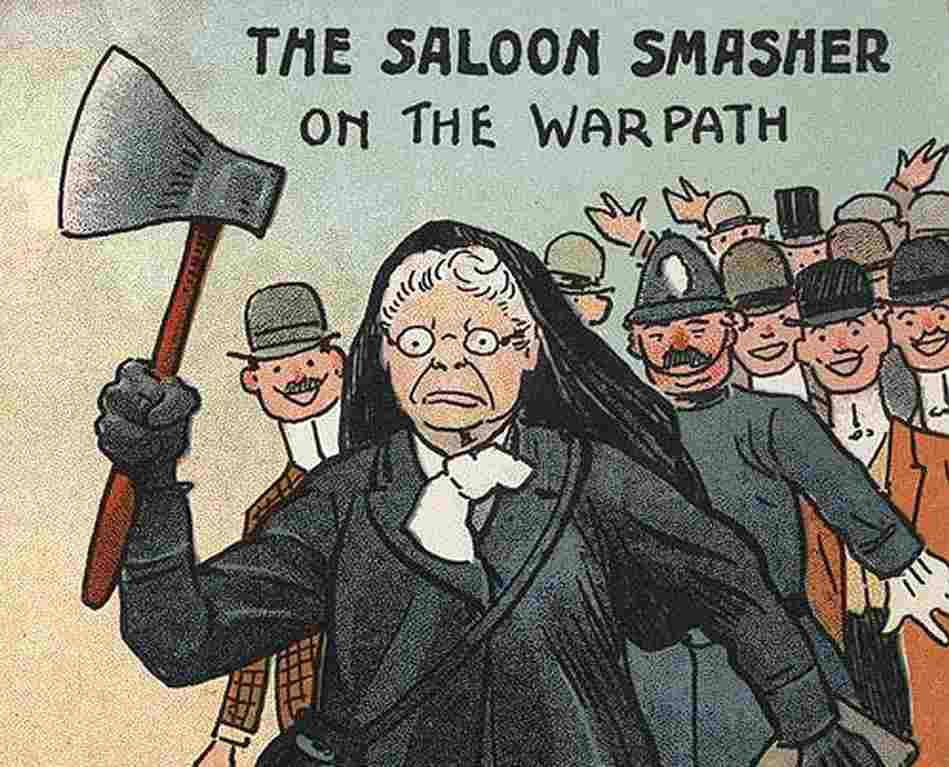
Brownstone Detectives investigates the history of our clients’ homes.
The story you are about to read was composed from research conducted in the course of one of those investigations.
Do you know the history of YOUR house?
********************************************************************************************************************************
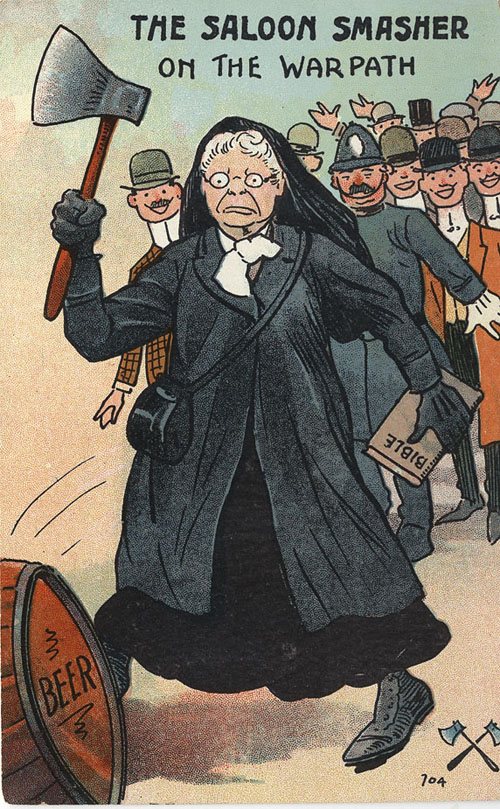 When Brooklyn saloon owners saw Carrie Nation entering their Broadway establishments carrying her ax, their first thought was to protect their liquor.
When Brooklyn saloon owners saw Carrie Nation entering their Broadway establishments carrying her ax, their first thought was to protect their liquor.
But when that grand and radical old figure of the Victorian temperance movement approached their bars, they were stunned at her request.
“Gimme a drink – or else!”
The original goal of Nation’s ax-swinging was to promote the temperance movement through the visual image of the destruction of its foe – liquor. It brought new prominence to a movement whose most visual image to date had been old women lambasting the drinking ways of men.
When she started swinging that ax, though, she got attention, and so, in extension, did the temperance movement.
CARRIE NATION – COMES TO BROOKLYN?
But Nation, whose anti-saloon message was promoted primarily in Kansas, was a shocking sight in the Eastern District of Broadway. She had recently visited New York City, though, and so no one was willing to challenge that ax in the bars up and down the avenue – even so close to the liquor center of Brooklyn – Bushwick Avenue.
“Dressed in a plush sacque, a neat fitting skirt, an old fashioned bonnet and carrying in one hand a dilapidated carpet bag and in the other a wooden ax, a person, – apparently a woman, caused a heap of excitement on Broadway late Saturday night,” reported the Brooklyn Daily Eagle in its 12 January 1903 broadsheet. “People out purchasing their supplies for the week stopped in their hurry to look and smile and it seemed as if all the kids in the vicinity were tagging up this Carrie Nation.”
The Brooklyn Standard Union noted that she “wore an old-fashioned crinoline dress, an old bonnet, and a liberal amount of rouge” on her face.
But the first indication that the “woman” was not who she seemed to be was the advertisements on the back of her “plush sacque” and on the carpet bag, which instructed onlookers to buy wines and liquors “at a certain place.”
But still, she had that ax.
CAROUSING CARRIE
And so through the night this walking advertisement “took to many places of brilliant lights and colored glass.” At every Broadway bar and saloon she entered, she flourished the ax. But she did not threaten to destroy their stock of liquor. Quite the opposite – she demanded “a drink or else.”
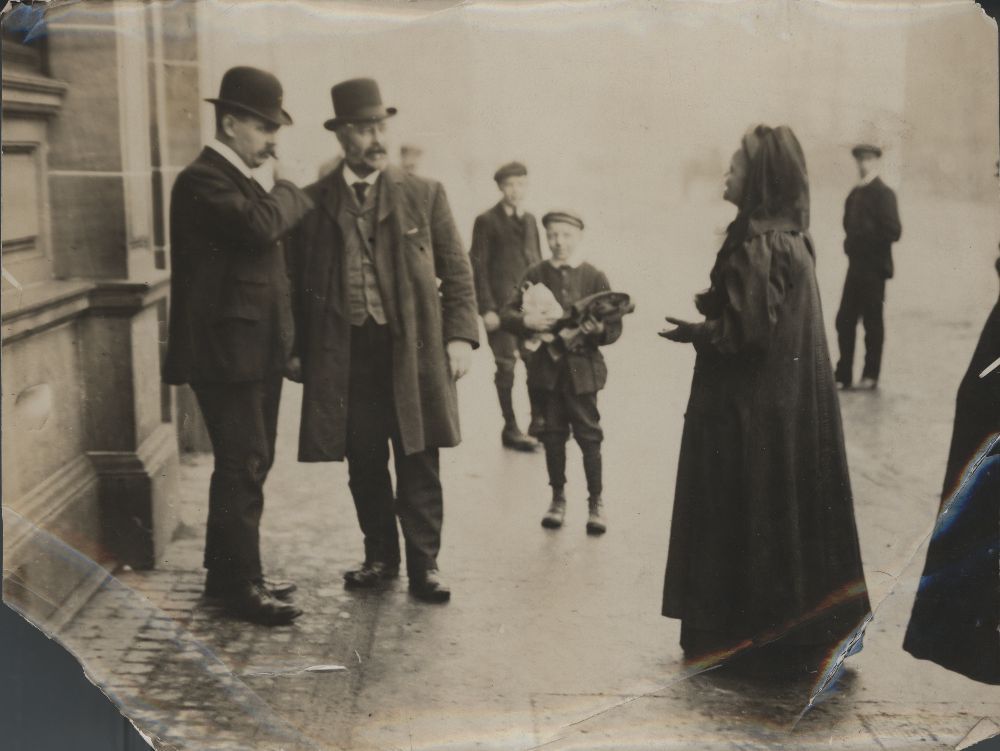
The scheme worked so well that toward midnight this Carrie Nation was “holding to a lamp post with one hand making savage dabs at the saloons as they whirled about her with the ax which she carried in the other hand.”
When the inevitable crowd began to gather at Broadway and Gates, Patrolman Fred W. Timm of the Ralph avenue station called the patrol wagon and helped the woman carefully into it. At the station house he assisted her to alight and then arraigned her before the desk. First, though, he told the driver not to go to “the barn” as they would have to take the prisoner to the Gates avenue station where there is a matron.
CARRIE IN COURT
“What’s yer name, madam?” asked the sergeant, who also felt some pity for the woman.
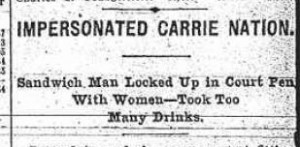
“Cleve Hardtt,” came the answer in the full resonance of a drunken man’s voice with about the same sweetness of a saw cutting into a knotted log.
“What! A man?” asked all the cops in unison.
“Shure, whas-hic-think – was – hic – goat?”
Cleve was locked up all night and the next morning and was finally arraigned before Magistrate Naumer in the Gates avenue court, still dressed in the woman’s clothes. When he was brought into court the officer in charge of the prisoners, not knowing the difference, had put him into the woman’s pen.
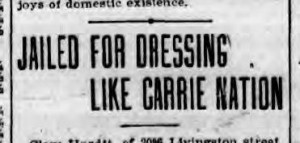
When Hardtt was arraigned before the magistrate he said he was 21 years old and that he lived at 196 Livingston Street. He said that once before he had been arrested and was let go in the Adams Street court.
“Why did you do this thing again, then?” asked the court.
“Well, the fellow that hired me said that he would see me through and then I took too many drinks, I guess.”
The wholesale liquor company that employed him to engage in this bit of guerrilla marketing was not “seeing him through” in court, though, according to Hardtt, and so he was fined $10 for his little fun, and jailed in lieu of that amount.
The court sent for his employer – and his clothes.
———————————————————————————————————————–
 Brownstone Detectives is an historic property research agency. Our mission is to document and save the histories of our clients’ homes. From our research, we produce our celebrated House History Books and House History Reports. Contact us today to begin discovering the history of your home.
Brownstone Detectives is an historic property research agency. Our mission is to document and save the histories of our clients’ homes. From our research, we produce our celebrated House History Books and House History Reports. Contact us today to begin discovering the history of your home.